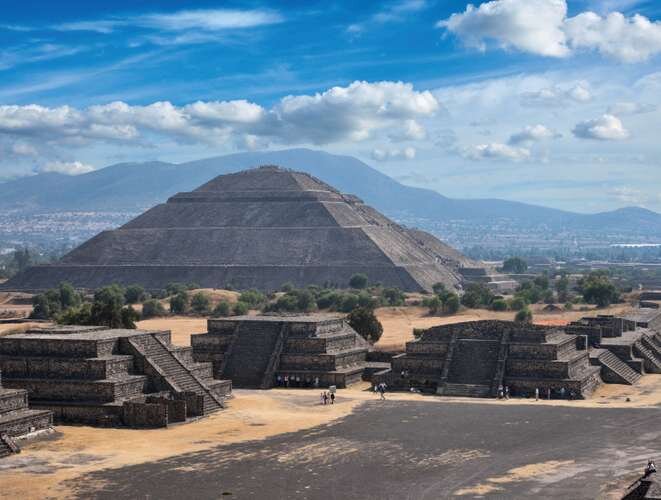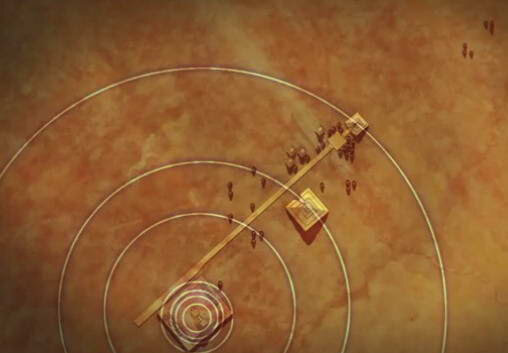The Pyramid Puzzle
It’s difficult to know where to start when trying to explain to people that the world is far more complex and mysterious than they imagine. And, in particular, that human history is vastly and fantastically (for the most part) different than what we have been taught. Where is the best entry point that will lead into the truly mind-blowing wombat hole that is our history on this planet?
Actually, it isn’t hard to know where to start, or to work out where this entry point is. It is, like it was for me, The Pyramids: a conspiracy of human history hiding in plain sight, offered to us by those of a distant past as a puzzle by which each of us can start piece together some of our collective but forgotten story.
Once one starts to piece together the pyramid puzzle, one begins to see our history with brand new eyes.
If we are to go in deep to the mystery of the pyramids, we must of course start with the biggest mystery of them all: The Great Pyramid of Giza.
The Great Pyramid of Giza. Source
The secrets of the Great Pyramid have been long parsed over — one of the earliest pioneers of this research being Peter Lemesurier in his epic book The Great Pyramid Decoded.
Before I try to do my humble best to explain the complexities of this structure, it is worth starting with this quote:
“Nobody alive today knows for certain how the Pyramid was erected, how long it was in the building, how its near-perfect alignments were achieved before the invention of the compass, or how its outer casing was jointed and polished with such unsurpassed accuracy. Nor have historians succeeded in producing any convincing theory as to why such an enormous undertaking, combined with such incredible accuracy, should have been deemed necessary for the construction of a mere tomb and funerary monument to a dead king who in any case apparently never occupied it” (p.6).
While the book was written over 40 years ago, the main point stands: anyone with definitive answers to the secrets of the Great Pyramid is either mistaken, telling porkies, or has access to sources of information outside of our mainstream paradigm.
We can start with the geometrical aspects in the above quote. The alignments of the Great Pyramid are remarkably accurate to a range of different points of reference. Its north/south and east/west axes align almost exactly (i.e. true to almost 5 minutes or one twelfth of a degree) with the the axes of the Earth. Zooming in on the area of Lower Egypt, we see that the Great Pyramid is also situated in the exact middle of the Nile Delta geometrical quadrant. There are several other noteworthy geographical novelties that have been noted, however since I don’t understand them myself, I won’t even try.
Ok, I’ll at least try. Basically, the Great Pyramid appears to have been encoded with mathematical information that shows a profound knowledge of the structure of the Earth. Taking the full height of the pyramid to be the top of the mysteriously missing capstone, the ratio between the base perimeter (that is, a circle that intersects each of the four corners of the structure) and the height is exactly 2 pi, meaning it is exactly the same ratio as a circle’s (or sphere’s) radius would be to its circumference. The pyramid is basically representing a hemisphere.
Not just any hemisphere: an exact 1:43,200 scale replica of the northern hemisphere of the Earth. This might sound like a bit of a stretch, except that the number 365.24 (the exact number of days in an earth year accurate to 5 digits) is encoded in various ways into the dimensions of the pyramid.
To again quote Lemesurier: “If one wished to have an architectural symbol for the planet Earth itself one could scarcely do better than to take the Great Pyramid of Giza”.
Look. I could go on further here summarising geometrical and mathematical intricacies that I barely understand myself. If this is your thing, then you probably already know about this aspect of the Pyramid Puzzle, as these alignments are established fact and common knowledge (see a lengthy summary on this page). Even better, you can watch this relatively short summary video or this longer one.
And that’s before we get to the size of the thing itself, which, incredibly, sits at twice the volume and thirty times the mass of the Empire State Building (I did double check this was thirty 30, and that’s what the book says).
The point of it all is this: The Great Pyramid is an astounding piece of architecture that leaves no doubt that its designer had access to scientific knowledge that is completely incompatible with our understanding of mankind at this period of time.
That leaves us with two possible conclusions: that it was not in fact constructed by man, but by a deity of some sort (or, as many have speculated, by aliens); or, more scientifically palatable, that human history is not what we have been lead to believe, and that we have at some time in our past possessed a level of knowledge that has since somehow become lost to us.
Despite the ridiculous mathematical wet dream that is the position, alignment and structure of the Great Pyramid, things get even more fascinating as we look at Giza as a whole.
What about the other pyramids in the area: the Pyramid of Khafre and the Pyramid of Menkaure? While not as impressive as architectural feats in themselves, they are nonetheless significant when taken together as a coherent architectural project.
Together, these three pyramids form an almost exact replica of the structure of the Orion’s Belt constellation. Going back to 10,500 BC, factoring in the turning of the sky due to the process of precession, Orion’s Belt would have been orientated directly due south of Giza in the exact arrangement of the three pyramids.
The Pyramids and the Constellation of Orion. Source
Sitting right next to the Great Pyramid is of course The Sphinx, which some would argue is an even greater head scratcher. The typical story put forward for its creation is as a monument to the Pharaoh Khafre sometime during his reign of 2520-2494BC.
Several people have called BS on this story. One in particular is Robert Schoch, who is a scholar both of Egyptian ancient architecture and geological events that shape their structure. His findings of significant water erosion on the Sphinx lead him to the conclusion that it must have been constructed at a time dating back to before the current arid desert conditions of the Giza Plateau, during a time when it experienced significant inundation. His theory is that its construction dates back to at least 12,000 years ago: that is, during the time of the last Younger Dryas ice age. It was the sudden end of this ice age and the mass flooding that ensued that likely accounts for the water marks on the Sphinx.
From an astronomical perspective, this would provide a logical explanation for the feline character of the structure, with this time period overlapping with the Age of Leo, or the lion. If we are to imagine the relationship between the heavens and the earth at this time in history — 10,500 BC to be exact — we would see the Sphinx aligned perfectly facing due east towards the Leo constellation as it would have been located for the Spring Equinox. Under this theory, we can see the Sphinx as a time stamp: a monument to a particular period of time rather than a monument to an egotistical leader — one who it is more likely simply decided to replace the existing feline face of this ancient statue with his own ugly mug.
Alignment of the Sphinx circa 10,500 BC. Source
So this is what we can see in the Giza Plateau: a master planned monument of a civilisation not only in the possession of advanced architectural and astronomical knowledge, but that has deliberately date stamped its work back to a time well before the acknowledged beginnings of human civilisation. It is not surprising then that the evidence presented by these pyramids has been used to argue for the existence of an ancient civilisation far more advanced than we can comprehend.
There is a lot more to be shared on the Great Pyramid of Giza, and the Giza pyramid complex as a whole.
As a taster, one of the more intriguing theories put forward by hardcore religious Egyptologists, and delved into in much detail in Lemesurier’s book, is of a prophetic code hidden in the finer details of the structure. A major example, and one that has excited many a Christian investigator, is that the angle of both the descending and descending shafts, when taken in a north west direction from the pyramid’s east axis, passes directly through that most famous birth towns in Bethlehem.
I also haven’t even gotten to the theories surrounding the internal function of the pyramids were — for example, intricate and elaborate initiation systems into spiritual mysteries such as enlightenment, rebirth and the afterlife; or even massive Tesla-esque energy conductors and healing centres — and that they clearly were not created simply as extravagant resting places for egotistical Pharaohs.
But that can be for a later time. I would like to finish with one of the most important pieces of the Pyramid Puzzle, one that can only be found by looking outside of Egypt.
Far from being a solely Egyptian achievement, evidence of pyramids and pyramidal structures have been or are now being uncovered round the world. Dr. Sam Osmanagich has been exploring and documenting the existence of pyramids in every continent on Earth, many of which demonstrate the same high-technology architectural flourishes that challenge our accepted paradigm of human history.
Others, such as those in Bosnia who Dr. Osmanagich has been fighting to have accepted and properly excavated for decades, have been written off as natural land formations given they are now covered by soil and vegetation. These groupings of pyramids demonstrate the same precise orientations and alignments that suggest a detailed knowledge of various other sciences, while having the potential — when their size can be fully known — to dwarf the Giza pyramids. If you have a spare hour and a quarter and want a proper deep dive into the Pyramid Puzzle, I highly recommend this lecture, which blew my mind when I first watched it and lead me down this wombat hole of alternative human history.
Screenshot from Osmanagich’s lecture showing the enormous size and pyramidal shape of the still un-excavated Bosnian Pyramid of the Sun.
Perhaps the most significant conventionally-accepted pyramids are those within South and Central America. As discussed through site visits by Graham Hancock in Fingerprints of the Gods, one of the most notable examples is the Mexican city of Teotihuacan: located 50 kilometres north-east of Mexico City and so filled with astronomical wonders in its layout that it has been called ‘a map of heaven’.
Pyramid of the Sun in Teotihuacan. Source
Like Giza, its central features are three pyramids — the Pyramid of the Moon, the Pyramid of the Sun, and the Pyramid of Quetzalcoatl, the civilising god-like figure of Central America following the Great Flood. These three structures are dispersed along the connecting axis of the Street of the Dead, and are arranged — just like in Giza — to be slightly off centre so as to match the astronomical arrangement of Orion’s Belt.
Alignments of Teotihuacan Pyramids (left), Orion’s Belt and Giza Pyramids (right). Source
In fact this reflection of stellar alignment could even be extended to the whole of the Street of the Dead itself, which has been suggested to represent a terrestrial counterpart to the entire Milky Way: similar to the way the Giza Pyramids are aligned so as to position the Nile River as an exact representation of the Milky Way.
Coincidence, or evidence of a common architect?
If so, it would be some architect: incredibly, considering that the outer planets of our solar system have only been (apparently) discovered within the last few centuries, it is suggested that the layout of the main features of Teotihuacan—starting from the Pyramid of Quetzalcoatl and incorporating the Sun Pyramid as Saturn and the Moon Pyramid as Uranus—map the exact orbital distances of the planets of our Solar System.
The (arguable) alignment of major Teotihuacan structures as planets of the Solar System. Source
And to top it off, just like in the Great Pyramid of Giza, there is clear evidence of the value of pi being incorporated into the design of the Pyramid of the Sun: a number whose mathematical significance was thought to have only been by Archimedes around the third century BC.
So, what shape do the pieces of the Pyramid Puzzle currently form?
We have evidence of the existence of an ancient Egyptian civilisation, far pre-dating what we currently call ‘ancient’ Egypt, more than likely active during the Younger Dryas Ice Age of roughly 10,500 BC. It is a civilisation with incredibly detailed knowledge of astronomy: of the makeup of the zodiac constellations and their cyclical movement through the sky by the process of precession that is still little understood today (more on this mysterious cosmic phenomenon in the future).
We combine that with an extraordinary level of architectural expertise that allows the design of these megalithic structures to be precisely encoded with a range of mathematical intricacies — including of measurements such as the dimensions of the earth and its distance from the sun that they really should have no idea about.
And then, we may even have to factor in the possibility that the pyramids themselves were not simply vain monuments to massive egos, but may have actually functioned as anything from intricate spiritual initiation complexes to some sort of epic power plant with the potential to create an energetic field conducive to human health and wellbeing.
And then: what if this knowledge wasn’t just unique to Egypt? What if there was in fact growing evidence that an advanced civilisations had been encoding a similar level of knowledge across all the continents of the world? What other conclusion can we come to that human history is clearly more complicated than what we have been told?
So really the question shouldn’t be whether on or not there was in fact some ancient and advanced human civilisation responsible for the creation of the Pyramid Puzzle: a puzzle that was clearly made to be discovered and solved.
The real question should be what happened to them.








